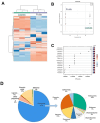The Phenolic Signature of Psidium cattleianum Fruits and Leaves Modulates TRPV1 and TRPA1 Transient Receptor Potential Channels: A Metabolomics, In Vitro, and In Silico Study
- PMID: 40129993
- PMCID: PMC11931593
- DOI: 10.1002/fsn3.70075
The Phenolic Signature of Psidium cattleianum Fruits and Leaves Modulates TRPV1 and TRPA1 Transient Receptor Potential Channels: A Metabolomics, In Vitro, and In Silico Study
Abstract
Although Psidium cattleianum (strawberry guava, Myrtaceae) is known for its anti-inflammatory, antioxidant, antimicrobial, and antidiabetic properties, its phytochemical profile and associated bioactivities remain largely underexplored. This study employed UHPLC-QTOF-HRMS for untargeted phenolic profiling of leaf and fruit extracts from P. cattleianum, followed by semi-quantification of phenolic subclasses and multivariate data analysis. Four hundred sixty-nine metabolites, including various phenolic subclasses-predominantly flavonoids and phenolic acids were- identified and annotated. Using HEK-293 cells stably transfected with TRPA1 or TRPV1 cation channels, it was found that both leaf and fruit extracts activate and rapidly desensitize TRPA1 in a concentration-dependent manner (EC50 18 and 30 μg/mL; IC50 60 and 47 μg/mL, respectively). Additionally, molecular docking analysis provided deeper insights into the interactions between P. cattleianum phytochemicals and the TRPA1 cation channel, identifying theaflavin 3,3'-O-digallate as the phenolic compound with the highest affinity (S score of -9.27 Kcal/mol). Interestingly, except for theaflavin 3,3'-O-digallate, compounds enriched in the leaf extract exhibited weaker binding interactions and lower S scores (approximately -7 Kcal/mol) compared to those enriched in the fruit extract. Also, a 100 ns molecular dynamics study of theaflavin 3,3'-O-digallate with TRAP1 demonstrated high binding stability of the complex. Overall, this study offers valuable insights into the phytochemical characteristics of P. cattleianum extracts and reveals their mechanism of action through affinity for the TRPA1 cation channel-receptors.
Keywords: Psidium cattleianum; TRP channels; metabolomics; molecular docking; myrtaceae; phenolic profiling.
© 2025 The Author(s). Food Science & Nutrition published by Wiley Periodicals LLC.
Conflict of interest statement
The authors declare no conflicts of interest.
Figures








Similar articles
-
Comparative analysis of the chemical composition and antioxidant activity of red (Psidium cattleianum) and yellow (Psidium cattleianum var. lucidum) strawberry guava fruit.J Food Sci. 2011 Sep;76(7):C991-6. doi: 10.1111/j.1750-3841.2011.02319.x. J Food Sci. 2011. PMID: 22417549
-
Psidium cattleianum fruit extracts are efficient in vitro scavengers of physiologically relevant reactive oxygen and nitrogen species.Food Chem. 2014 Dec 15;165:140-8. doi: 10.1016/j.foodchem.2014.05.079. Epub 2014 May 22. Food Chem. 2014. PMID: 25038660
-
Comprehensive assessment of the antidiarrheal properties of polyphenols from Psidium cattleianum Sabine's aerial parts.J Ethnopharmacol. 2025 Apr 25;346:119670. doi: 10.1016/j.jep.2025.119670. Epub 2025 Mar 25. J Ethnopharmacol. 2025. PMID: 40147676
-
Psidium cattleianum fruits: A review on its composition and bioactivity.Food Chem. 2018 Aug 30;258:95-103. doi: 10.1016/j.foodchem.2018.03.024. Epub 2018 Mar 8. Food Chem. 2018. PMID: 29655760 Review.
-
Guava (Psidium guajava L.) Leaves: Nutritional Composition, Phytochemical Profile, and Health-Promoting Bioactivities.Foods. 2021 Apr 1;10(4):752. doi: 10.3390/foods10040752. Foods. 2021. PMID: 33916183 Free PMC article. Review.
References
-
- Angulo‐López, J. E. , Flores‐Gallegos A. C., Torres‐León C., Ramírez‐Guzmán K. N., Martínez G. A., and Aguilar C. N.. 2021. “Guava (Psidium Guajava l.) Fruit and Valorization of Industrialization By‐Products.” PRO 9, no. 6: 1–17. 10.3390/pr9061075. - DOI
LinkOut - more resources
Full Text Sources
Miscellaneous

